Forsythia plant care and growing tips: follow our expert advice
Find out how to grow forsythia with our expert guidance on planting and caring for this spring-flowering favorite
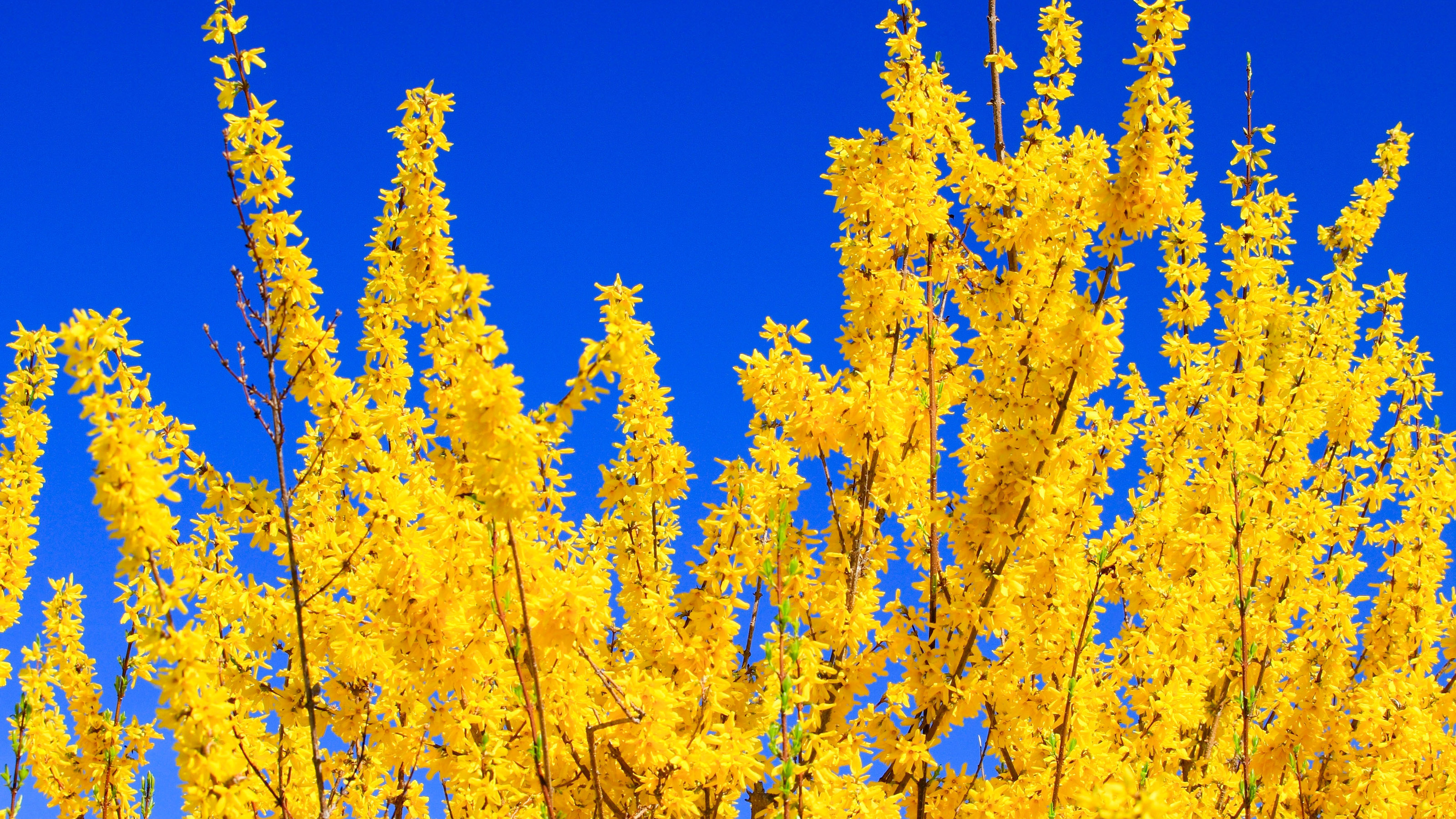

Few shrubs bring such dazzling colour as forsythia – heralding spring at the close of what will have felt like many gloomy months. The vivid yellow flowers burst forth from winter branches. If you see a gleam of shining canary yellow flashing in the winter light, it will be a forsythia.
These are vigorous deciduous shrubs that will take almost any temperatures winter throws at them. They are hardy down to zone 3 in the US. If left unpruned, the plants develop into large bushes that may reach 10ft (3m) in height or more. However, pruning has a dramatic influence on their size. Some dwarf varieties are naturally much more compact.
Flowers line their bare branches in late winter and early spring. In some varieties they are crowded tightly, while in others they are a little more distantly spaced. Up to five flowers are clustered together at each leaf joint. Each one is more or less bell-shaped, with four evenly spaced points, and up to 1in (2.5cm) across.
Forsythia flowers are yellow: some are golden, a few are primrose yellow. If you’re contemplating uplifting flowerbed ideas, forsythia provides a joyous backdrop to a spring display. The time at which flowers open, and how long they remain bright, is controlled by a combination of rising temperatures and lengthening days. In mild areas, flowers open earlier.
The leaves develop after flowering, or soon before the flowers fade. For the rest of the year until the leaves drop in the fall, there is not much to see. With forsythias, it is all about that bright early display. Here we show you how to grow your own for vivid spring color – and care for your forsythia to guarantee a cheery yellow spectacle year after year.
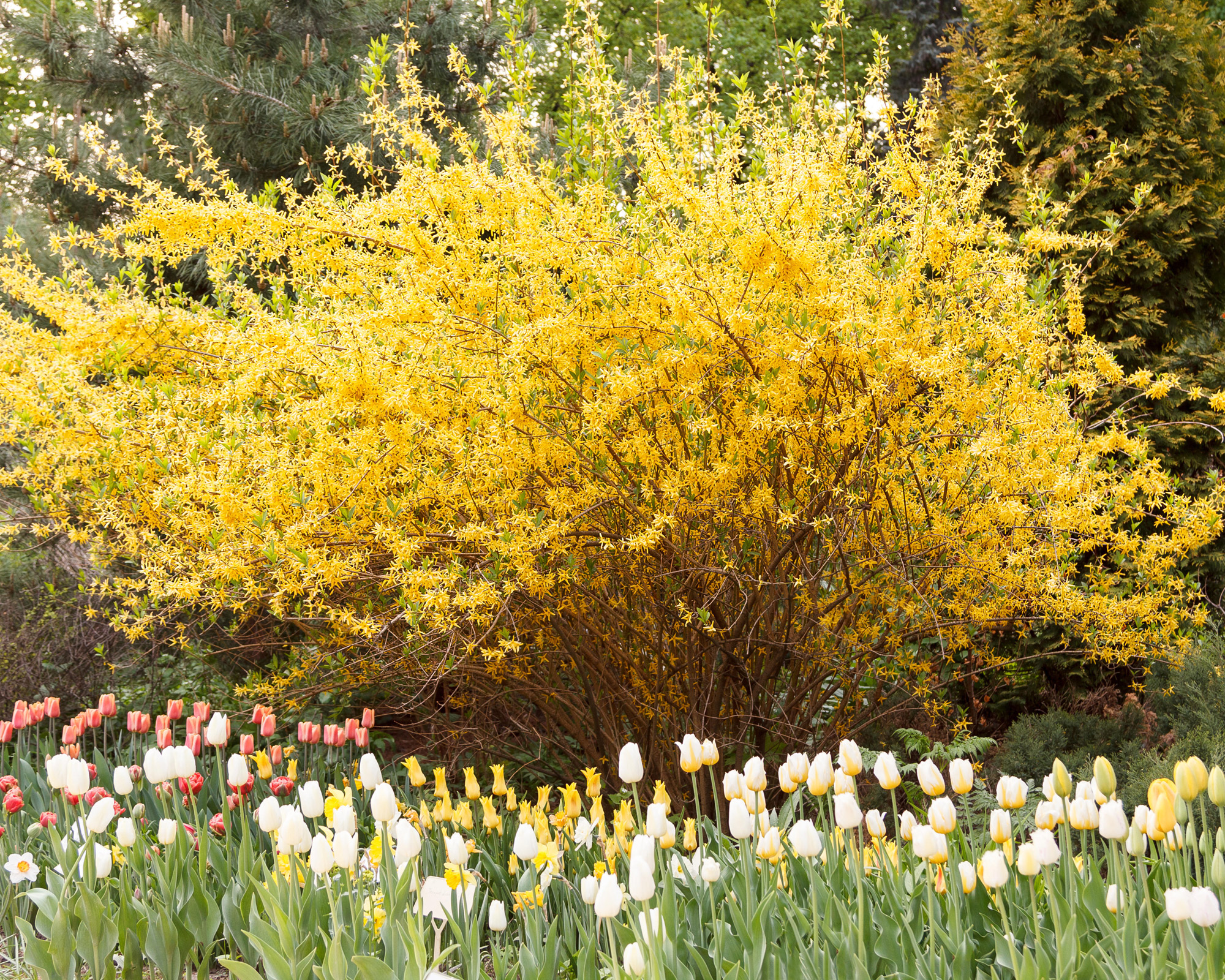
Spring display of tulips in front of a spectacular yellow forsythia bush
When to plant forsythia
Forsythia can be planted at any time that the soil is not parched or frozen. However, planting in summer is not recommended for these plants, except in the coolest areas. This is because your newly planted forsythia will need regular watering to be kept at its best.
Plants in containers bring you the widest planting window. Fall, or late winter and spring, are the best times. However, in mild areas, where long hard frosts are rare, container forsythia can be planted in winter, too.
If you are looking to plant bare root plants, these are best planted in mid to late fall. The roots will start to grow before winter, so when the main surge of growth comes in spring the roots are already developing. Planting in early spring is the alternative. Knowing when to water plants will help keep your newly planted forsythia in good condition, whenever you plant it.
If you buy forsythia with their roots and soil wrapped in burlap, try to plant them as soon as possible. If they must wait, ensure that the roots stay moist.

Forsythias in pots can be planted from autumn to spring, as long as the ground is not frozen
Where to plant forsythia
Forsythia plants enjoy plenty of sunshine, so don’t plant them under deciduous or evergreen trees. A few will grow well against a fence or wall, and even a north-facing wall in many areas. However, most are best as specimens planted at the back of garden borders to give them space to grow.
Forsythia works well planted along boundaries – in late winter, there will be few plants to block the view of their arriving flowers. Later on, their summer foliage makes a good background for smaller plants and a useful support for vines. The shorter-growing varieties available are also good for foundation planting. If you are looking to make a small garden look bigger, these types of forsythia can dazzle in smaller planting areas.
For those looking for new container gardening ideas, we sometimes see shorter varieties planted in ornamental containers. However, although the plants are very colorful in flower, for most of the year they look rather dull and will then need moving to an out-of-the-way corner.
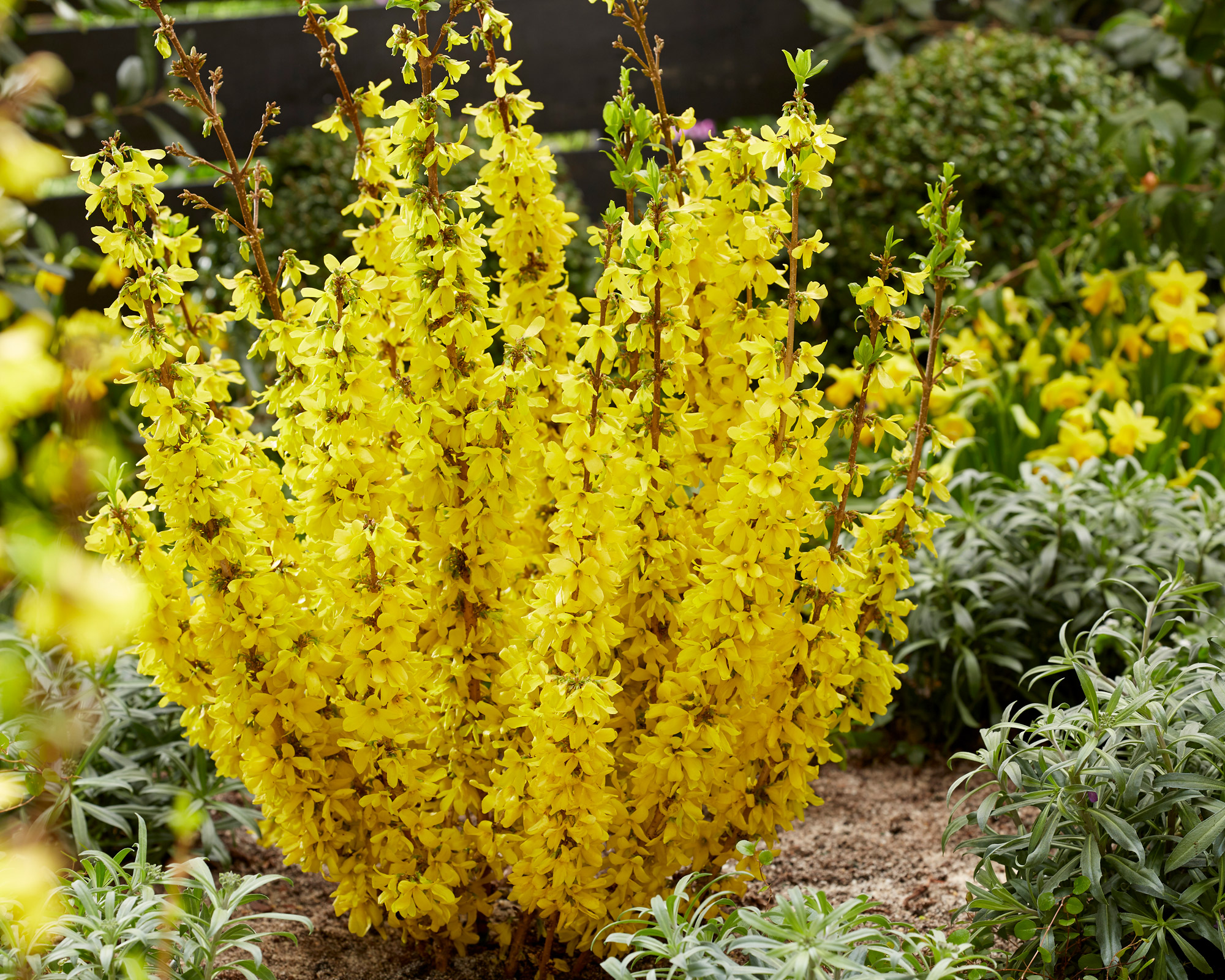
Forsythia 'Mikador', like all dwarf types, is easy to position in a border
How to plant a potted forsythia
Forsythias in containers are planted in much the same way as other shrubs, but most are vigorous in growth so they appreciate thorough soil preparation. Fertilize the planting site with a general feed the day before planting. Forsythia is tolerant of most soil conditions, though it seems to like clay and loam soils best of all. Following our guide to soil types can help you gauge the quality of your soil before planting.
Then just follow these simple steps:
- Dig a hole twice as deep and as wide as the container. Work plenty of garden compost or organic matter into the base of the hole. If you have tried your hand at composting, use some of this. Then firm well.
- Remove the forsythia from its pot and stand it in the planting hole. Add or remove soil until the plant sits a little below soil level.
- Mix some organic matter with the soil from the hole. Use this to fill in around the sides of the rootball.
- Finish by fertilizing again. Then mulch with chipped bark or other weed-free organic matter.
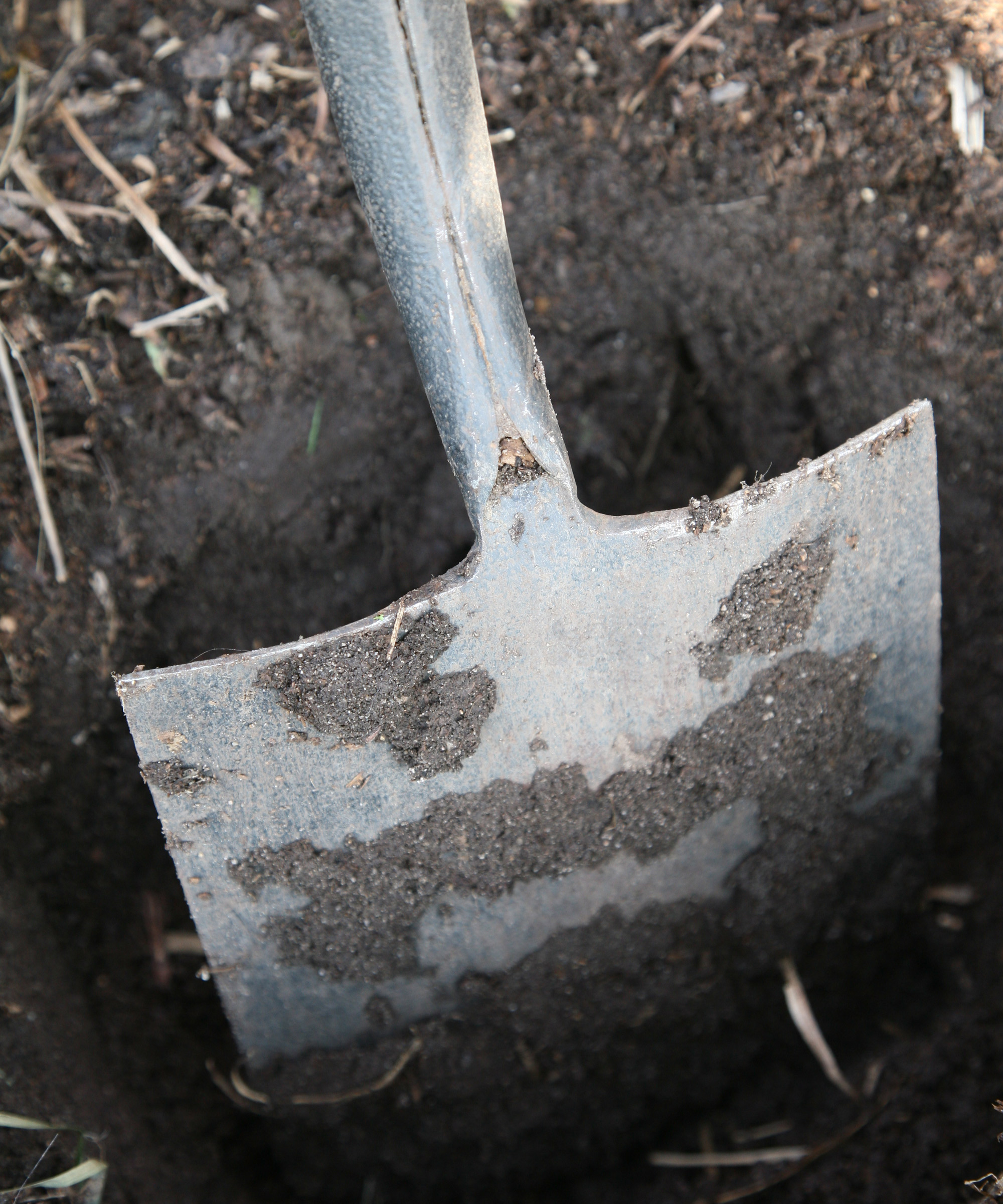
Planting a potted forsythia is quite straightforward as long as you prep the soil thoroughly and dig correctly before planting
How to plant a bare root forsythia
Before planting a bare root forsythia, unpack it and soak it overnight in a bucket of half-strength general-purpose plant food. As with potted types, it’s wise to improve the planting site with organic matter forked into the soil, and firm well. Then follow these three steps:
- Grab your best garden spade or hand trowel to make a planting hole a little larger than the roots.
- Spread the roots of the bare root forsythia out in the hole. Work soil in amongst them. Then firm well with your fingers. Water in thoroughly.
- Finish with a 2in (5cm) layer of weed-free mulch.
If you are planting a burlapped plant (with roots wrapped in burlap), prepare the planting site as you would for potted forsythia, but make a slightly larger hole. Carefully remove the burlap before slipping the rootball into the hole, disturbing the roots as little as possible.

Plant bare root forsythia such as these 'Lynwood' shrubs from HedgesDirect.co.uk as soon as you receive them
How to care for forsythia
Forsythia are tough plants, both in terms of being winter-hardy down to zone 3, and also in tolerating poor growing conditions. For this reason, you should have few issues when mastering how to grow forsythia.
Most will grow strongly without special feeding. However, in poor soil an annual feed of rose fertilizer will be greatly appreciated. An annual fall mulching of weed-free compost or other organic matter will also help to smother weeds and retain soil moisture.
Forsythia plants appreciate plenty of sunshine so if trees or larger plants growing nearby begin to cast shade, take action – pruning shrubs around your forsythia will let in more light. Forsythia will often continue to grow in increasing shade, but will become spindly and flowering will become thin.
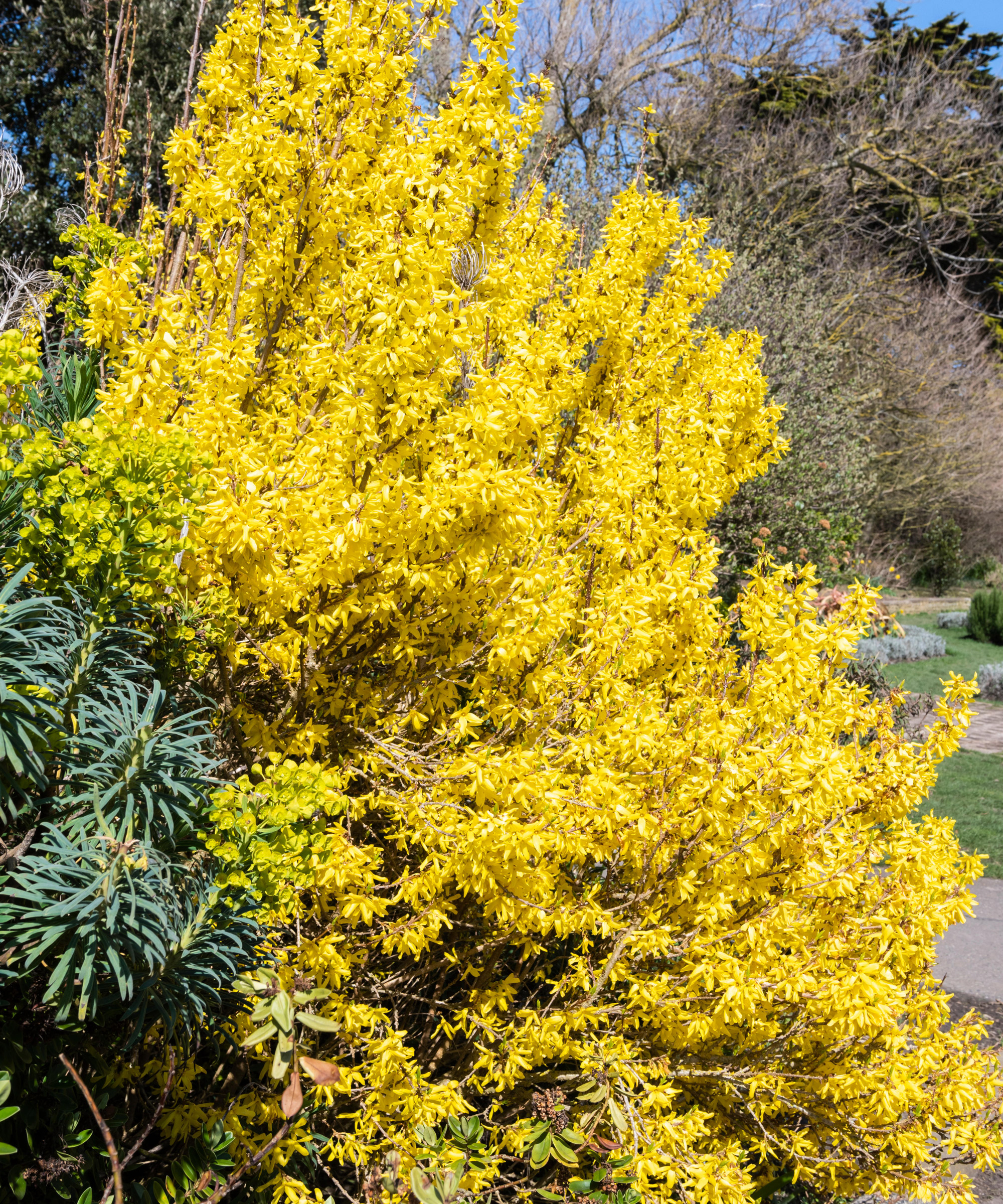
With the right sunny spot, there are few care essentials to worry about with your spring flowering forsythia
Plants to grow with forsythia
When choosing plants to grow with your forsythia, lovers of companion planting can approach this in a couple of ways. Your selections might depend on whether you see your forsythia as a smart background for other plants, or whether you wish to use it as a form of support.
For much of the year, when there are no flowers, your forsythia will look rather dull. The trick here is to use it as a support for a vine that flowers in summer, long after the forsythia flowers have faded. If you are keen on learning how to grow clematis, forsythia is a good partnering plant for summer-flowering clematis as it will give that support. And for those interested in knowing how to grow sweet peas, the same applies. Other good choices are purple wisteria and canary creeper.
You can also think about your forsythia as a background for summer color, particularly if you are interested in cottage garden ideas and wish to recreate the effect yourself. Flowers with an upright, vertical look fit well, so consider delphiniums, tall snapdragons, mullein, lupines and astilbes.
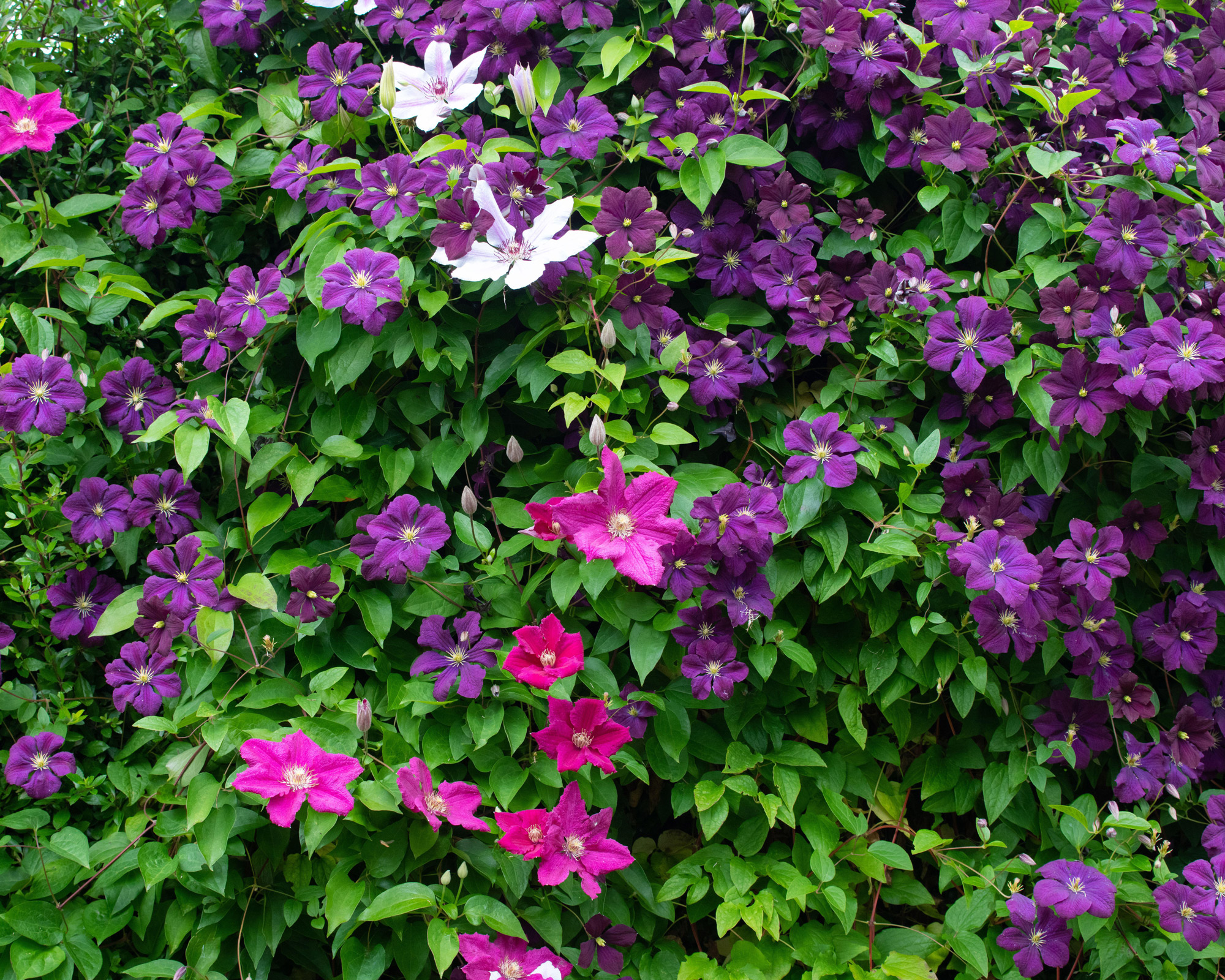
Forsythia provides support for clematis such as ‘Etoile Violette’ and others from the Viticella group
Forsythia problems and how to solve them
Once your forsythia is in the ground and established, and as long as you can handle the occasional bit of pruning, there are few things to worry about. Forsythia is generally trouble-free. However, keep a watchful eye out for the following and act accordingly!
- Occasionally, shrubs may be attacked by bugs. It might help to know how to get rid of aphids in particular. However, aphids generally do little harm. Understanding about plants that repel insects and siting some of these close by can also keep your forsythia well and happy.
- In winter, after the leaves have fallen, you may notice knobbly lumps on the twigs. These are called galls and are usually caused by a fungus disrupting the natural growth of a twig or flower. Galls look unsightly, but they can be snipped off with pruners. They do little harm, and if you have one or two on your forsythia they will not spread to other plants.
- Your forsythia may not flower: the most common reason is because of pruning forsythia at the wrong time. If you prune in late autumn, winter or early spring (when you prune your roses or butterfly bush), you will cut off the flower buds! Wait until after your forsythia has flowered – then prune.
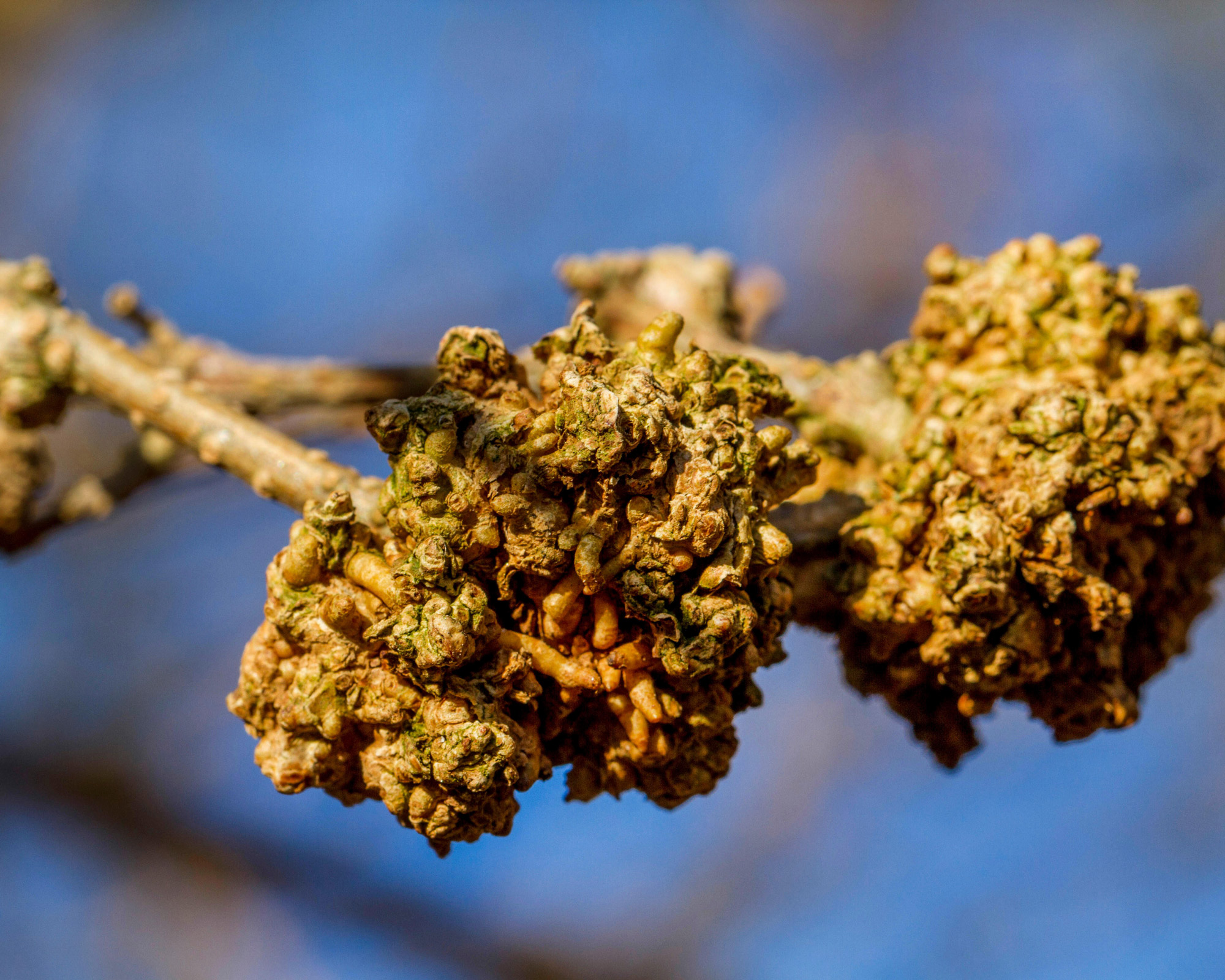
Forsythia gall (irregular bumps that develop along the stems) can develop in winter, but it is nothing to worry about
Forsythia propagation
If you want to make more forsythia, there are a couple of ways to do it. The simplest way to propagate forsythia is to look for a low shoot, near the ground, in summer. Press it to the soil and weigh it down by placing a brick or a large stone on it.
Keep the shoot in contact with the soil and prevent it from moving. Over a few months, roots develop from any leaf joints touching the soil. The following spring, new shoots develop. You can then snip off the shoot with its roots and plant it elsewhere. Grow on alongside the best evergreen perennials and the best foliage plants and you’re all set.
The other approach is to grow new forsythias from cuttings. If you have some experience in how to take cuttings from plants you may prefer to try this approach instead. Follow these four steps for cutting success:
- In late fall, use your pruners or best secateurs to snip off young shoots 12in (30cm) long. Trim the tip of each above a leaf joint, and the base below a leaf joint – leaving a cutting around 10in (25cm) long.
- Find a bright corner of the garden in good soil. Use a spade to make a slit in the soil 6in (15cm) deep.
- Drop the forsythia cuttings vertically into the slit, making sure they are the right way up. Position them 6in (15cm) apart. Use your foot to then close the slit, firming the soil around the cuttings.
- In spring, your cuttings should start to grow. These new forsythia plants can then be carefully dug up and replanted. Remember to find a spot that receives plenty of sunshine to give your forsythia the best start.

Propagate forsythia by layering: select a young shot and pull it horizontal so a section is in contact with the soil, then weigh it down
Are there any dwarf forsythias?
Forsythia tends to be associated with sweeping masses of yellow flowers. And yes, to be fair, many of these shrubs do conform to that type. But while forsythia may often be on the large side (like Forsythia suspensa, the weeping forsythia, for example), there are alternatives if you’re after the best shrubs for small gardens and need to scale down your planting expectations a little.
If you would like to grow forsythia in a more compact gardening space, you can. For many years, the most popular varieties were the vigorous ‘Lynwood’, fountain-style ‘Beatrix Farrand’ and graceful arching ‘Karl Sax’ – but these are strong-growing. More recently, though, shorter and bushier varieties have been introduced. Look for ‘Gold Tide’ (Marie D’Or), ‘Show Off Sugar Baby’, ‘Show Off Starlet’ and ‘Minigold’.

Compact forsythia variety ‘Show off’ is ideal for small spaces
Are all forsythias yellow?
From ‘Lynwood Gold’, 'Gold Rush’ and ‘Gold Tide’ to ‘Goldilocks Courtacour’, there seems to be a common unifying quality to all forsythia – and that is the color. Most images you see tend to focus on the dazzling vibrant golds synonymous with the forsythia - and many of the cultivar names back this up. All great news for lovers of yellow flowers – and yet you may also have heard of ‘white forsythia’.
So let’s clear this up: all forsythia are yellow. However, there is a plant with white flowers that looks similar. This scrambling deciduous shrub is called the white forsythia. Its scientific name is Abeliophyllum and it flowers earlier, is less vigorous, and is less often seen in nurseries. If you love white flowers, this fragrant forsythia-alike is also a sun lover and also spring flowering, followed by glossy green leaves that turn purple in autumn. An interesting interloper in the field of forsythia!
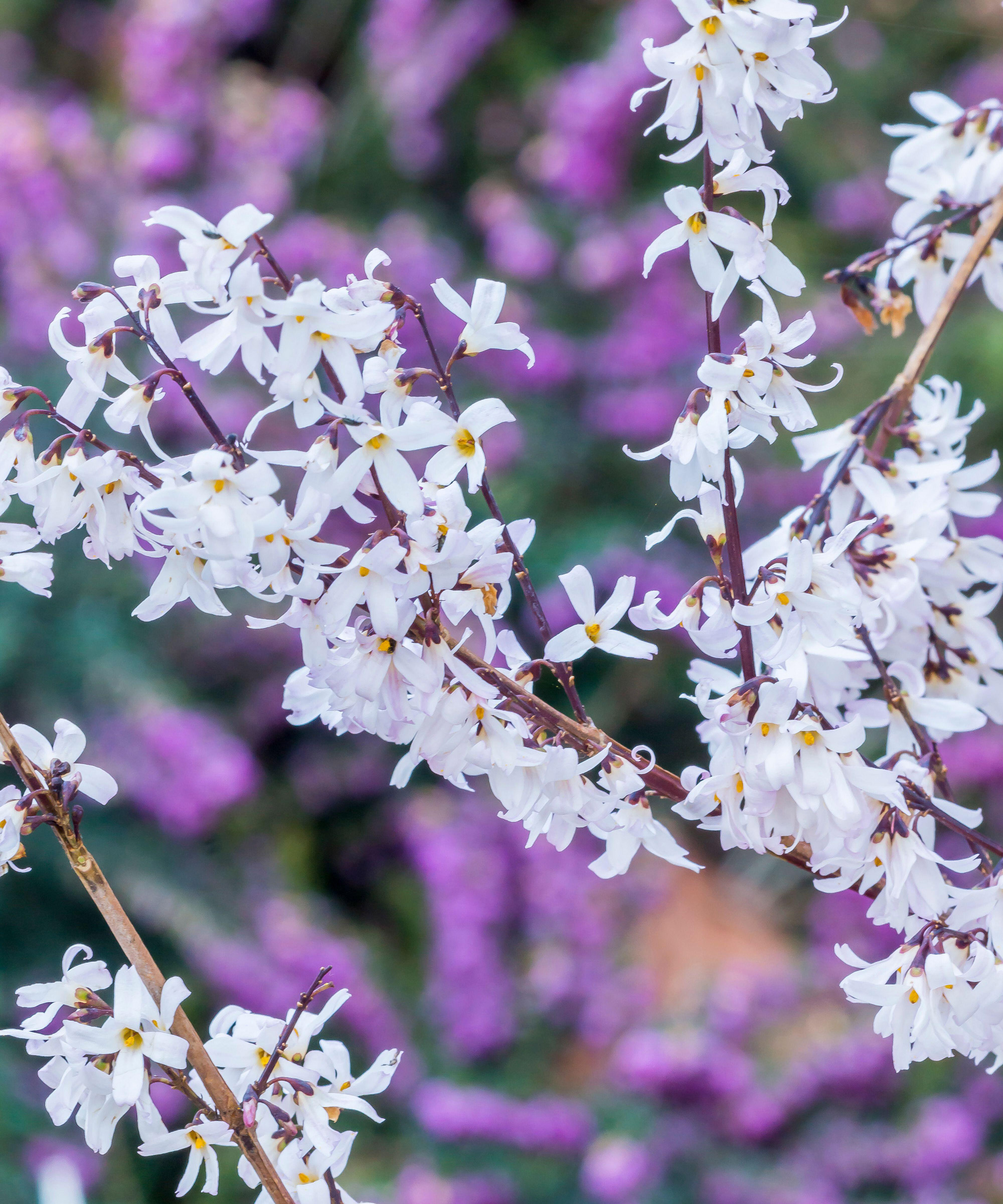
Abeliophyllum distichum, also known as the white forsythia, produces pretty star-shaped white flowers with a slight pink flush
Where does forsythia come from?
You may sometimes see forsythia growing by the side of the road and wonder where they came from. You may even wonder if they are native. No, they were brought over from Asia in the 1800s by Scottish botanist William Forsyth, after whom this shrub is named.
However, we do sometimes get forsythia ‘growing wild’ away from gardens. Flowering so brightly and so early, they are very noticeable. This is usually the result of yard waste being dumped. Alternatively, it could be because of the branches of a large plant touching the ground and taking root. Occasionally, forsythia spreads by seeds.
For those of you who have an interest in rewilding your garden, forsythia is an inspiring shrub that combines an easygoing growing habit with a tough, adaptable nature. Because it has found more than one way to flourish, it quickly establishes itself in all kinds of spaces.
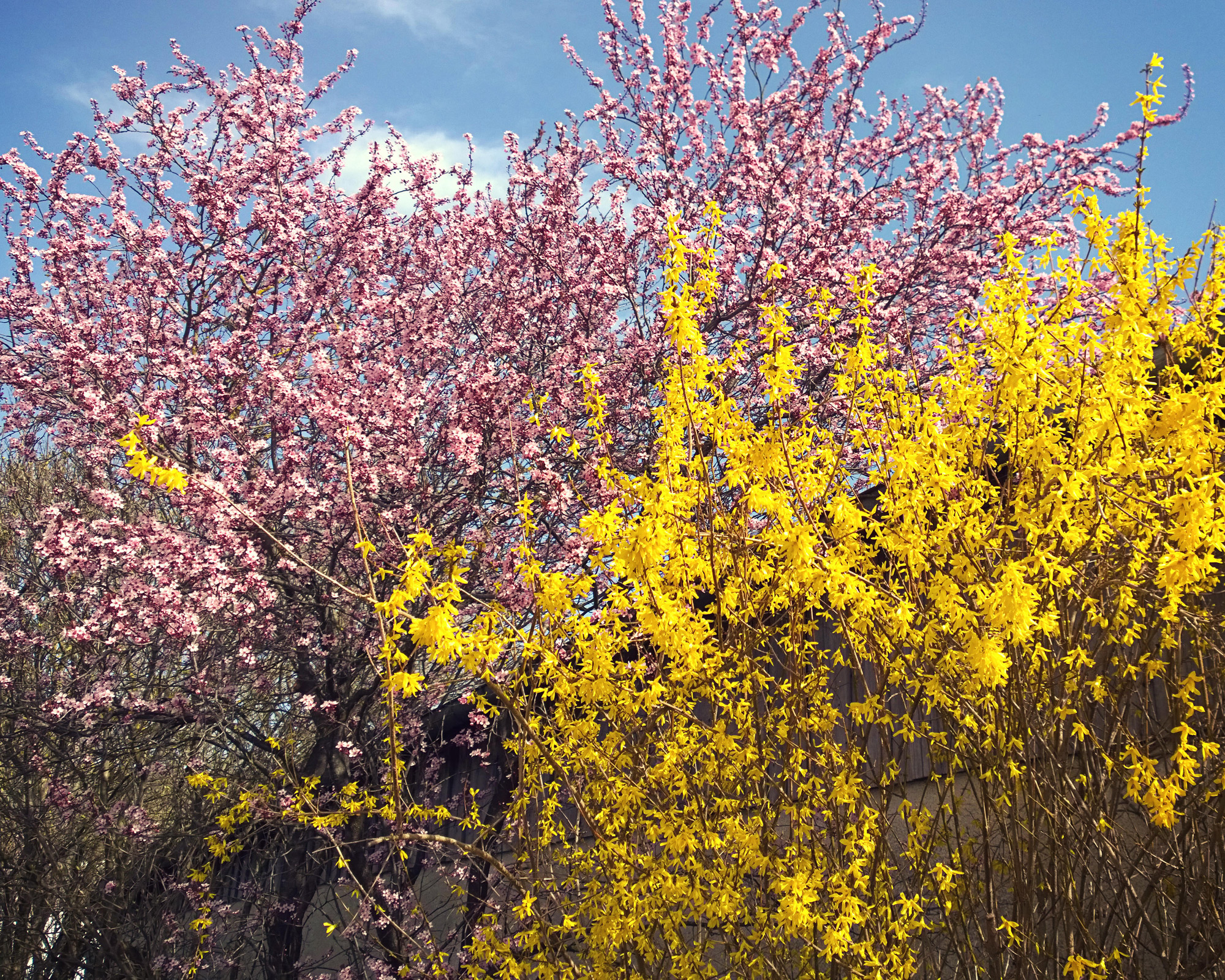
Forsythia can be found ‘growing wild’ , as seen here growing alongside a pink cherry tree
Where to buy forsythia
Forsythias are usually sold in nurseries and garden centers in gallon (or larger) containers. If you buy mail order, you may receive plants in quart or gallon pots or you may also receive bare-root plants. These are dug up from the nursery with the soil shaken off the roots. Removing soil greatly reduces shipping costs. The nursery will send them at the right planting time for your area – they must be planted as soon as you receive them.
In some nurseries and garden centres, you may also see large flowering forsythias up to 6ft (1.8m) tall sold in full bloom. The soil is retained on the roots and the whole rootball wrapped tightly in burlap. Here are our suggestions for the best places to buy. Use our quick links below for an easy way to start.
Where to buy forsythia in the US:
- Shop forsythia plants at Dancing Oaks
- Shop forsythia plants at Home Depot
- Shop forsythia plants at Monrovia
- Shop forsythia plants at Nature Hills
- Shop forsythia plants at Proven Winners
- Shop forsythia plants at White Flower Farm
Where to buy forsythia in the UK:

Graham Rice is a garden writer who has won awards for his work online, and in books and magazines, on both sides of the Atlantic. He is a member of a number of Royal Horticultural Society committees and the recipient of the 2021 Garden Media Guild Lifetime Achievement Award.
